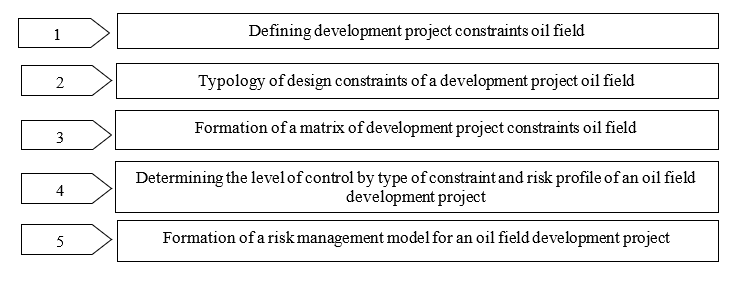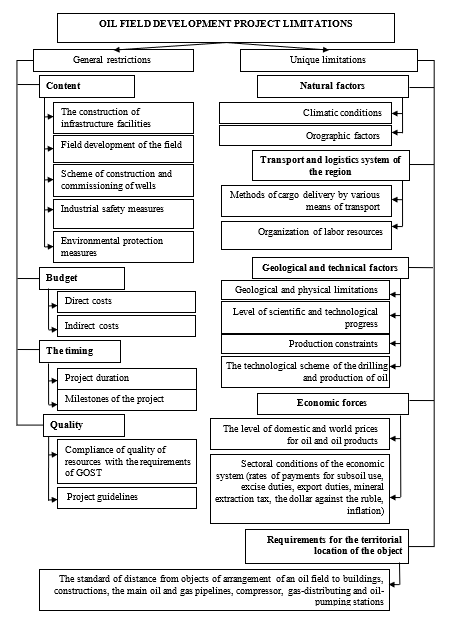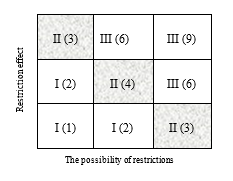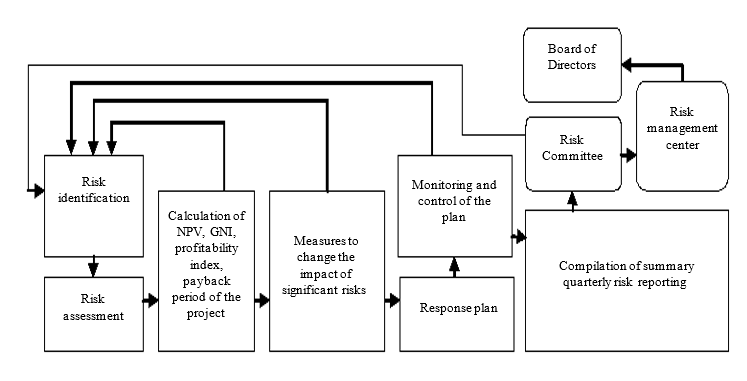Abstract
This article is devoted to identifying and evaluating specific project constraints in the implementation of oil field development projects. The author's approach to managing the limitations of the development project, taking into account the industry specifics, is presented. By managing the constraints of an oil field development project, the authors understand the process of forming and making a management decision aimed at identifying and classifying by types of limiting factors that affect the profitability and risks of projects. The study formed a sequence of stages for identifying, evaluating, and managing project constraints, and established the relationship between the riskiness of the development project and the levels of project constraints management. The typology and characteristics of the management levels of project constraints are given and the actions of the Manager for each level are defined. A grouping of development project risks in the context of limiting factors and a method for determining classes of restrictions is proposed. The study identified 22 key constraints inherent in development projects and formed a system of values of the score scale for evaluating the levels of project constraint management. The relationship between the project's risk profile and the levels of project constraints management is established. Unmodified and partially modifiable constraints are considered as areas for further identification and assessment of project risks. The proposed concept will provide the project Manager and potential investors with the necessary information to make decisions about whether to participate in the project and provide methods for responding to risk.
Keywords: Design constraintsriskoilfield development projectcontrollability levelrank of constraint
Introduction
The business management of modern oil companies is based on the project approach, due to the increase in the number and cost of oil field development projects, which are characterized by a significant implementation time and, therefore, high risks. Therefore, the issues of assessing and accounting for uncertainty factors, and the search for methods to increase the adaptability of oil projects to actual conditions of implementation, are especially relevant today.
Any project for the development of an oil field is carried out in an environment whose inherent feature is uncertainty (Nielsen, 2007), related to both the incompleteness of information on the conditions for the implementation of the project, industry-specific design constraints, and expected results. An important aspect of the development project is the geological information obtained in the course of geological, geophysical and geochemical studies, and depends on the ability to interpret the data obtained. Therefore, uncertainty in oil field development projects is present (Khalikova, Gerasimova, & Prokofieva, 2019) both at the stage of exploration and subsequent stages of development.
Uncertainty is due to the presence of factors (Sokolov & Tokarev, 2008), in which the results of actions are not deterministic, and the assessment of the influence of these factors on the profitability of the project is unknown.
From the point of view of project management, such factors within the framework of the project are project limitations, which are the main source of project risks, since there is always an uncertainty in the implementation of a particular restriction.
Problem Statement
According to GOST 32359-2013 «Oil and gas and oil fields. Development design rules», the development of an oil field should be carried out in accordance with the approved project document, the type of which is determined depending on the stage of development. This document sets forth technical and technological measures, control over the process of developing an oil field and separately identifies factors that limit the design of development.
According to Theory of Constraints (TOC) “restriction” is what prevents an organization from achieving its goal (Dettmer, 1998). The theory of constraints gives a systematic look at projects (Leach, 2014), considers them in dynamics and allows predicting how successful the implementation will be, and how changes in the conditions of activity will affect the entire project management system.
According to the state standard of the Russian Federation - GOST R 54869-2011 "Requirements for project management" the definition of the concept of restriction is interpreted as a constraining factor affecting the progress of the project. At the same time, the limitations themselves are not defined in GOST, and only the functional areas of project management are indicated: content, timing, costs, risks, quality and others.
During the life of the project, management focuses mainly on three basic parameters of design constraints: the volume of work performed (subject to the content of the project), time and resources (Gerasimova & Yamilova, 2017). The triple constraint or “project triangle” is the traditional way to measure the success of any project. However, the industry specific limitations of the project are not fully taken into account.
The current practice of project management has a large number of foreign national and international standards (Avdeeva & Gerasimova, 2015), among which a special position is held by the Guide to the Project Management Body of Knowledge - (PMBOK) (PMA, 2013) and the International Project Management Standard ISO 21500: Guidance on project management.
The PMBOK stipulates that one of the project management processes is balancing the competing limitations of the project, including the content, quality, schedule, budget, resources, risks, and also states that changing project requirements or project goals may cause additional risks (PMA, 2013). Risks, in turn, can affect the content of the project, the timing or budget of the project. In this way, PMBOK extends the project triangle and shows the relationship between project constraints and project risks.
According to ISO 21500: Guidance on project management, project constraints are barriers placed on a project. Among the limitations, this standard defines: duration, budget, resources; factors related to the health and safety of staff; acceptable risk level; potential social or environmental impacts of the project; laws, regulations and other legal requirements.
All of the above indicates the growing relevance of the problem of the lack of not only a unified approach to the composition of design constraints, but also the assessment of specific industry constraints, associated primarily with the diversity of their types.
Research Questions
It is impossible to manage restrictions on oil field development projects without identifying and systematizing specific types of restrictions, evaluating them, and monitoring them. Therefore, in the framework of the study, initially, it is necessary to determine and rank specific limitations of development projects in the context of classification features. Classification of these restrictions will allow us to develop a detailed program for responding to uncertainty (Badiru & Osisanya, 2013) during the project implementation, aimed at increasing its profitability while minimizing risk.
Purpose of the Study
The purpose of this study is to develop a methodological approach to assessing the level of management of restrictions of an oil field development project, in accordance with their type and impact on the project result. In order to achieve the goal, it is necessary to create a system for managing the limitations of the oil field development project, which allows identifying the risk groups of the project in the context of limiting factors. The final result of the study should be a formed risk management model for the oil field development project.
Research Methods
This study presents the author's approach to managing the limitations of an oil field development project, taking into account industry specifics.
Under the constraints of a project for developing an oil field, the authors understand the process of developing and making a managerial decision aimed at identifying and classifying by type of limiting factors that affect the profitability of the project and increase its risks.
As part of the analysis of the impact of restrictions on the profitability of an oil field development project, a sequence of stages for identifying, evaluating and managing project limitations has been formed (Figure

Consider each stage of the constraint management system in more detail.
At the first stage, determining the limitations of the oil field development project, the authors proceeded from the specifics of the sequence of development and operation of oil fields (Suda, Rani, Abdul-Rahman, & Chen, 2015), which consisted in changing the volume of oil production depending on the stage of field operation and were based on geological, technical, logistic and economic information (Figure
When structuring design constraints, it must be taken into account that all limiting factors can be divided into general, inherent in any oil field development project, and unique, inherent in a specific development project.

In the second phase defined the concept of "type of design constraint", which is a set of unique characteristics project limitations based on which you can judge the level of impact of limiting factors on the profitability of the project, to identify significant risks and determine the key actions of the project manager (Table
The third stage involves the definition of a class and the formation of a matrix of limitations of the oil field development project. To form a matrix, it is necessary to evaluate the possibility of a restriction (Table
An assessment of the impact of a project constraint is considered from the perspective of the materiality of the impact on project profitability.
Next, the class of each constraint is determined by the formula (1) and a class table is formed (Table
Where: Cc is the class of each constraint, Pl is the possibility of a limitation, Ia is an assessment of the impact of restrictions on the profitability of the project.
On the basis of this information, a matrix of project constraints is formed, which allows to demonstrate the impact of constraints on the project result (Figure

As part of the fourth stage, the authors identified 22 key constraints inherent in oil field development projects and determined the values of the scale for assessing levels of management of project limitations. When grading the scale and determining the level of management, the authors proceeded from the scope of authority of the project manager and the functional duties performed by him related to the ability to influence project limitations.
As a result, the scale has the following meanings:
Modifiable restrictions - 3 points;
Partially modified restrictions - 2 points;
Unmodifiable restrictions - 1 point.
The scale of management levels will have three sections allocated according to the following principle: most of the design constraints should be of the same level that is 12 of 22, the rest should be of the neighboring level, two constraints through the level are allowed (Table
After determining the level of management of the limiting factors of the project, it is advisable to identify the risks inherent in each level and determine their impact on project profitability. At the same time, the authors proceeded from the interpretation of risk contained in GOST R 54869-2011 «Requirements for project management»: risk is “a likely event for the project, the occurrence of which can both negatively and positively affect the results of the project”. Therefore, risk is an economic category that reflects the impact of limiting factors on project profitability. The more moderate the risk of a development project, the greater its ability to adapt to the constraints under consideration.
At the fifth stage, the risks are grouped (Skogdalen, 2011) according to the degree of materiality of the impact on the target settings and profitability of the project. For this, it is necessary to concentrate on non-modifiable and partially modifiable constraints (Table
To increase the adaptability of the project and minimize the negative consequences of its risks on the activities of the oil company as a whole, it is necessary to use an integrated risk management system based on the interconnection of the stages of project risk management and the oil company’s risks (Figure

This system will ensure the most effective achievement of the goals, since the information obtained at each stage will allow to adjust not only the methods of exposure to risk, but also the objectives of risk management.
Findings
The following results were obtained in the study:
1.A methodological approach was developed to assess the level of management of restrictions in the oil field development project, in accordance with their type and impact on the project result.
2.Identify specific features of realization of projects of development of oil fields, entailing negative consequences on increasing risk component and identify specific limitations of the project development, based on which we generated a typology of constraints of the development project, taking into account the level of impact of constraints on project profitability, and identified the key actions of the project Manager.
3.A system for determining the class and forming a matrix of restrictions for an oil field development project has been formed.
4.A score scale was developed for evaluating management levels by types of limitation of the development project and a risk profile for each level was presented, which allowed grouping the risks of the oil field development project in the context of limiting factors.
5.As part of improving the adaptability of the development project, the oil company has developed an integrated risk management system for the oil field development project.
Conclusion
The proposed concept of managing the limitations of an oil field development project will provide the project Manager and potential investors with the necessary information to make decisions about whether to participate in the project, and provide methods for responding to significant risk. The established system of integrated project risk management will ensure effective and comprehensive management of all significant risks affecting the project, taking into account the interdependence of risks among themselves. All this will contribute to building a corporate culture of risk management within the company and integrating risk management into strategic management.
References
- Avdeeva, L. A., & Gerasimova, M. V. (2015). Problems of standardization of oil and gas investment project management. Naukovedeniye, 7(3), 23EVN315. DOI: 10.15862/23EVN315
- Badiru, A. B., & Osisanya, S. O. (2013). Project management for the oil and gas industry: A world system approach. Boca Raton: CRC Press.
- Boldyrev, E. S., Burenina, I. V., & Zakharova, I. M. (2016). Risk accounting in the evaluation of investment projects in the oil and gas industry. Naukovedeniye, 8(1). DOI: 10.15862/48EVN116
- Dettmer, H. W. (1998). Constraint theory a logic-based approach to system improvement. Milwaukee, WI: ASQ Quality Press.
- Gerasimova, M. V., & Yamilova, Y. V. (2017). Methodological aspects of the formation of a strategic risk management system for oil and gas projects. Eurasian Law Journal, 5(108), 331-335.
- GOST 32359-2013 «Oil and gas and oil fields. Development design rules». Retrieved from http://docs.cntd.ru/document/1200107868 Accessed: 14.11.2019.
- GOST R 54869-2011 «Requirements for project management». Retrieved from http://docs.cntd.ru/document/gost-r-54869-2011 Accessed: 14.11.2019.
- ISO 21500: Guidance on project management. URL: https://www.isopm.ru/download/iso_21500.pdf
- Khalikova, M. A., Gerasimova, M. V., & Prokofieva, P. E. (2019). Assessment and analysis of the risks of an oil company in making strategic management decisions. Economics and Management: A Scientific and Practical Journal, 1(145), 31-34.
- Leach, L. P. (2014). Critical chain project management. Norwood, M.A.: Artech House.
- Nielsen K. R. (2007). Current risk management issues in the oil & gas industry. Pegasus Global Holdings. Retrieved from http://www.pegasus-global.com/assets/newsletters/2009/06/Deutsche-Bank-Oil-and-Gas-Conf-2007.pdf Accessed: 26.12.2019.
- PMA (2013). Guide to the project management body of knowledge (PMBOK® Guide) - Fifth edition. Newtown Square, P.A.: Project Management Institute, Inc. Retrieved from https://dinus.ac.id/repository/docs/ajar/PMBOKGuide_5th_Ed.pdf Accessed: 14.11.2019.
- Skogdalen, J. E. (2011). Risk management in the oil and gas industryntegration of human, organisational and technical factors: PhD thesis UiS. Stavanger: University of Stavanger.
- Sokolov, V. G., & Tokarev, A. N. (2008). Analysis of innovative projects in the face of uncertainty. In N.V. Fadeykina (Ed.), Inter-Regional Scientific and Practical Conference and XI Scientific Session of the Professor-Teaching Staff of SAFBD. Collection of Scientific Works on Materials of the Interregional Scientific and Practical Conferences (pp.293-305). Novosibirsk: Siberian Academy of Finance and Banking.
- Suda, K. A., Rani, N. S. A., Abdul-Rahman, H., & Chen, W. (2015). A review on risks and project risks management: Oil and gas industry. International Journal of Scientific & Engineering Research, 6(8), 938-943.
- Tasmukhanova, A. E. (2016). Existing risk management methods and their applicability in oil and gas exploration and development projects. Bulletin of Economics and Management, 1(2), 88-92.
Copyright information

This work is licensed under a Creative Commons Attribution-NonCommercial-NoDerivatives 4.0 International License.
About this article
Publication Date
01 April 2020
Article Doi
eBook ISBN
978-1-80296-081-5
Publisher
European Publisher
Volume
82
Print ISBN (optional)
-
Edition Number
1st Edition
Pages
1-1004
Subjects
Business, innovation, management, management techniques, development studies
Cite this article as:
Burenina, I. V., Gerasimova, M. V., Evtushenko, E. V., & Khalikova, M. A. (2020). Development Of A Constraint Management Methodology For An Oil Field Development Project. In V. V. Mantulenko (Ed.), Problems of Enterprise Development: Theory and Practice, vol 82. European Proceedings of Social and Behavioural Sciences (pp. 121-131). European Publisher. https://doi.org/10.15405/epsbs.2020.04.16
